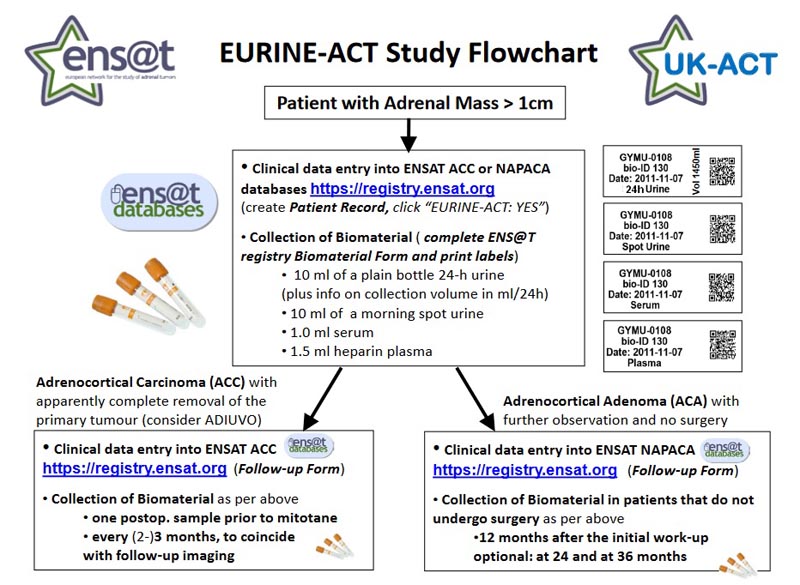Background Benign adrenal tumors are commonly discovered on cross-sectional imaging. Mild autonomic cortisol secretion (MACS) is regularly diagnosed, but its effect on cardiometabolic disease in affected individuals is poorly defined. Aim: To determine the burden of cardiometabolic disease and steroid excretion in people with benign adrenal tumors with and without MACS. Design: Cross-sectional study, 14 endocrine secondary and tertiary care centers (hiring from 2011 to 2016). Participants: 1305 prospectively recruited people with benign adrenal tumors. Measurements: Cortisol excess was defined by clinical assessment and overnight dexamethasone suppression test 1 mg (serum cortisol: <50 nmol/L, non-functional adrenal tumor [NFAT]; 50 to 138 nmol/L, possible MACS [MACS -1]; > 138 nmol/L and absence of clinical features typical of Cushing syndrome [CS], definitive MACS [MACS-2]). Net steroid production was assessed by 24-hour urine multisteroid profile using tandem mass spectrometry. Results: Of the 1305 participants, 49.7% had NFAT (n = 649; 64.1% women), 34.6% had MACS-1 (n = 451; 67.2% women), 10.7% had MACS-2 (n = 140; 73.6% women) and 5.0% had CS (n = 65; 86.2% women). The prevalence and severity of hypertension were higher in MACS-2 and CS than in NFAT (adjusted prevalence ratios [aPRs] for hypertension : MACS-2, 1.15 [95% CI, 1.04 to 1.27] and CS, 1.37 [CI, 1.16 to 1.62]; aPR for the use of ≥3 antihypertensive drugs: MACS-2, 1.31 [CI, 1.02 to 1.68] and CS, 2.22 [CI, 1.62 to 3.05]). Type 2 diabetes was more prevalent in CS than in NFAT (aPR, 1.62 [CI, 1.08 to 2.42]) and was more likely to require insulin treatment for MACS-2 (aPR, 1.89 [ CI, 1.01 to 3.52]) and CS (aPR, 3.06 [CI, 1.60 to 5.85]). Multisteroid urinary profile revealed an increase in glucocorticoid excretion of NFAT over MACS-1 and MACS-2 to CS, while androgen excretion decreased. Limitations: Cross section design; possible selection bias. Conclusion: A cardiometabolic risk condition, MACS predominantly affects women and warrants regular screening for hypertension and type 2 diabetes. |
Comments
Scientists are calling for changes in healthcare policy after research that has shown for the first time the magnitude of the impact of a condition associated with benign tumors that can lead to type 2 diabetes.
Incidental adrenal lesions are found during abdominal imaging in 2% to 7% of adults, and determining their cause and potential for malignancy, as well as their levels of excessive hormonal secretion, presents a challenge to clinicians. Most commonly, these lesions are benign adrenocortical adenomas without apparent excess steroid production.
However, adenomas produce mild excess cortisol without clinical manifestations of Cushing’s syndrome (CS) in approximately 35% of cases, a condition formerly known as subclinical CS. Patients with overt adrenal CS are usually diagnosed during investigation of specific symptoms rather than by abdominal imaging for unrelated reasons.
Scientists at the University of Birmingham are calling for changes to healthcare policy following research that has shown for the first time the magnitude of the impact of a condition associated with benign tumors that can lead to type 2 diabetes and high blood pressure.
Up to 10 percent of adults have a benign tumor, or lump, known as an "adrenal incidentaloma" in the adrenal glands that produce a variety of hormones. Incidentalomas may be associated with the overproduction of hormones, including the steroid stress hormone cortisol , which can lead to type 2 diabetes and high blood pressure.
Previous small studies suggested that one in three adrenal incidentalomas produces excess cortisol, a condition called Mild Autonomous Cortisol Secretion (MACS).
Now, an international research team led by the University of Birmingham in the United Kingdom has carried out the largest prospective study ever conducted of more than 1,305 patients with adrenal incidentalomas to assess their risk of high blood pressure and type 2 diabetes and their production. of cortisol, comparing patients with and without MACS.
The study is also the first to perform a detailed analysis of steroid hormone production in patients by analyzing cortisol and related hormones using mass spectrometry in 24-hour urine samples they collected.
Their study findings, published in the journal Annals of Internal Medicine , show that MACS is much more common than previously reported: Nearly one in two patients in the study with an adrenal incidentaloma has MACS. In particular, 70% of MACS patients were women and most of them were of postmenopausal age (over 50 years).
Following their findings, researchers now estimate that up to 1.3 million adults in the UK could have MACS. Considering that around two in three of these patients are women, MACS is potentially a key factor for women’s metabolic health, particularly in women after menopause.
First author Dr Alessandro Prete, from the Metabolism and Systems Research Institute at the University of Birmingham, said: “Compared to those without MACS, we observed that patients with MACS were more likely to be diagnosed with high blood pressure and requiring three or more medications to achieve adequate blood pressure control. When we looked at patients with a diagnosis of type 2 diabetes , those with MACS were twice as likely to be treated with insulin, indicating that other medications have not helped control their blood sugar levels. In conclusion, our study found that MACS is very common and is an important risk condition for high blood pressure and type 2 diabetes , especially in older women, and the impact of MACS on high blood pressure and type 2 diabetes risk has been underestimated until now."
Lead author Professor Wiebke Arlt, director of the Metabolism and Systems Research Institute at the University of Birmingham, said: “Previous studies have suggested that MACS is associated with poor health. However, our study is the largest ever conducted to conclusively establish the extent and severity of high blood pressure and type 2 diabetes in patients with MACS. Our hope is that this research will shine a spotlight on this condition and increase awareness of its impact on health. We advocate that all patients who are carriers of adrenal incidentaloma be screened for MACS and have their blood pressure and glucose levels measured regularly ."
Dr Lucy Chambers, Head of Research Communications at Diabetes UK, said: “This important research, funded by Diabetes UK, reveals that a condition associated with benign adrenal tumours, mild autonomic cortisol secretion (MACS), is more common. and may have more of a negative impact on health, including increasing the risk of type 2 diabetes, than previously thought. These findings suggest that screening for MACS could help identify people, particularly women, in whom the condition has been found to be more common, who may benefit from support to reduce their risk of type 2 diabetes. We look forward to more Research to find out how MACS is linked to an increased risk of type 2 diabetes, which in the future could lead to new ways to treat and prevent type 2 diabetes in people with MACS. “If you have MACS and are concerned about your risk of type 2 diabetes, it is important to speak to your GP or endocrinologist.”
Professor Arlt added: “Now that we have established that MACS is an important risk factor for high blood pressure and type 2 diabetes, our research will focus on three main areas. First, we want to investigate how MACS is related to this increased risk by investigating how excess cortisol affects human metabolism. Second, we are working on a test that can be used in the clinic to identify early which patients with MACS are at higher risk of developing high blood pressure and type 2 diabetes. Third, we are testing new treatment strategies for mitigate this risk for affected people. Our ultimate goal is to improve the health of the many patients living with MACS.”
The research, which took three years to complete, is part of EURINE-ACT , which is the largest international prospective multicenter study to date in patients with newly diagnosed adrenal tumors. This first research effort of its kind was achieved through collaboration with an international network of centers specializing in adrenal tumors known as the European Network for the Study of Adrenal Tumors (ENSAT).
The study was funded by Diabetes UK, the European Commission, the Medical Research Council and the Claire Khan Trust Fund at University Hospitals Birmingham Charity.
The EURINE-ACT study It is an international prospective study examining the diagnostic and prognostic value of urinary steroidobolomics in patients with adrenocortical tumors. Urinary steroidobolomics is the combination of steroid profiling using gas chromatography/mass spectrometry (GC/MS) followed by data analysis using machine learning analysis. The study is led by Professor Wiebke Arlt from the University of Birmingham. In previous cross-sectional studies, Birmingham has established through collaboration with ENS@T that urinary steroidobolomics can differentiate between benign and malignant adrenocortical tumors using a simple urine test that appears to have higher specificity and sensitivity comparable to imaging techniques. This will now be tested prospectively in the EURINE-ACT trial with many ENS@T centers and the UK Adrenocortical Tumor Network UK-ACT already actively recruiting. The graphic below provides a brief overview of the study. We aim to recruit patients with any adrenal mass > 1 cm and need to enter the clinical information into the appropriate ENS@T database (ENS@T ACC for adrenocortical carcinoma, ENS@T NAPACA for any other adrenal mass/adrenal incidentaloma ). The necessary biomaterial consists of a 24-h urine sample, a spot urine sample, a serum, and a heparin plasma sample. Patients with confirmed ACC may participate in the EURINE-ACT ACC follow-up group offering urinary steroidobolomics every 3 months after apparent complete surgical removal of the primary tumor. This arm aims to evaluate the sensitivity of the approach for detection of recurrence compared to imaging and will also analyze steroid changes induced by mitotane treatment. Patients with an adrenal incidentaloma believed to be an inactive endocrine adrenocortical adenoma may participate in the EURINE-ACT ACA follow-up arm, with biomaterial required 6 and 12 months after initial diagnosis and annually thereafter. This arm aims to detect whether adrenal incidentalomas show evidence of potentially harmful excess hormone production during the first three years after initial diagnosis.
|

















